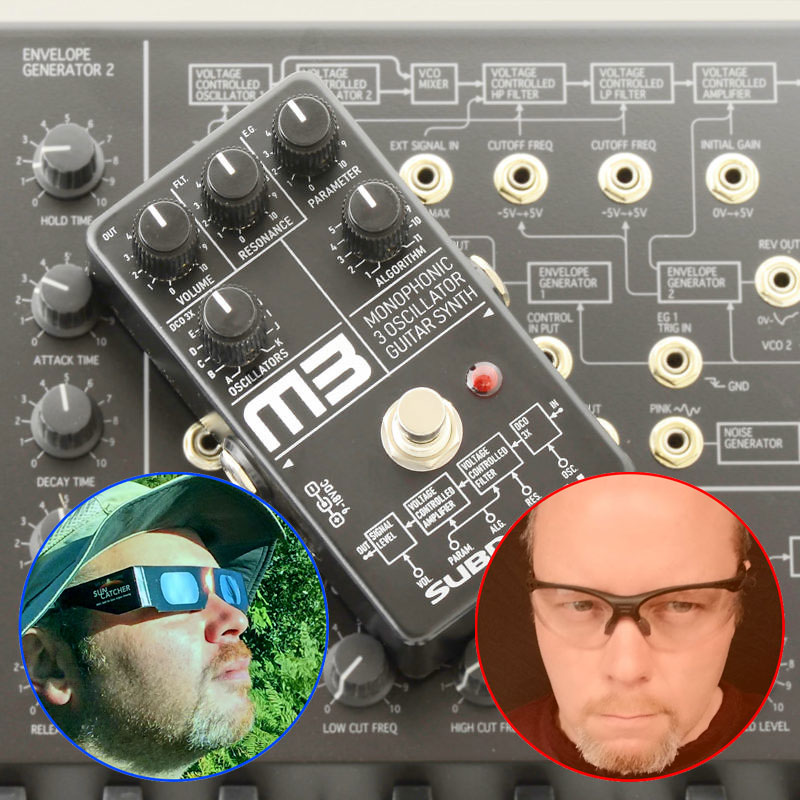 Brian: So tell us about how the M3 was created. What was going on? How did it get started?
Brian: So tell us about how the M3 was created. What was going on? How did it get started?
 Brian: Sure. Right from the inception of Subdecay, I harbored an audacious dream – to birth a synth pedal that’d defy the boundaries of convention, or at least sound like an actual synthesizer instead of a fuzzy filter. The saga of the M3 synthesizer pedal is a wild roller-coaster, or at least a long drive with some twists and turns.
Brian: Sure. Right from the inception of Subdecay, I harbored an audacious dream – to birth a synth pedal that’d defy the boundaries of convention, or at least sound like an actual synthesizer instead of a fuzzy filter. The saga of the M3 synthesizer pedal is a wild roller-coaster, or at least a long drive with some twists and turns.
2017 was not fun. I’d suffered a back injury. I could barely walk. Some days I spent laying on the floor. It pretty much sucked. But in those dark times I had time to read and hone my coding skills. If it weren’t for spending months in relative stasis I’m not certain I’d have journeyed down this road. As the universe conspired to close the doors a window opened.
For anyone following us over the years, you’ve witnessed the Ocasynth released in 2011. It was one late night summer night, under the pale glow of candle light…
 Brian: Um yeah. Are you calling me a liar?
Brian: Um yeah. Are you calling me a liar?
 Brian: You started off like a discount Hunter S Thompson, and now you’re trying to tell me you design pedals like a 18th century settler. I think you’re embellishing things.
Brian: You started off like a discount Hunter S Thompson, and now you’re trying to tell me you design pedals like a 18th century settler. I think you’re embellishing things.
 Brian: Okay, fine. It wasn’t candle light. It was the unrelenting glare of metal halide shop lights that I dared to confront the perilous seas of synthesis. In a matter of mere hours, I emerged with an entire design and ordered circuit boards.
Brian: Okay, fine. It wasn’t candle light. It was the unrelenting glare of metal halide shop lights that I dared to confront the perilous seas of synthesis. In a matter of mere hours, I emerged with an entire design and ordered circuit boards.
But do not be beguiled by this seemingly miraculous revelation. The path was fraught with missteps, earlier attempts that could only be described as dismal failures. Behold, a 12-knob monstrosity that threatened to unleash chaos upon the universe, an enigma so treacherous that even I, its creator, struggled to rein in its chaotic powers. I could not reel this behemoth of the sea on to my vessel. Digital control and presets? A mere mirage in the cosmic desert, far from my grasp at the time.
 Brian: So you’re an AI generated 2007 pedal builder larping mad scientist now?
Brian: So you’re an AI generated 2007 pedal builder larping mad scientist now?
 Brian: Hey, we all did it back then.
Brian: Hey, we all did it back then.
 Brian: Can I get back to telling my story now?
Brian: Can I get back to telling my story now?
 Brian: The journey commenced with a clear vision and a will for precision. Each knob had a role to play. My mission was to forge a sound that transcended earthly norms. It had to resonate as a symphonic octaves, not merely a jumble of fuzz coursing through a humble filter. The trials of past prototypes and experiments laid the groundwork for this audacious voyage.
Brian: The journey commenced with a clear vision and a will for precision. Each knob had a role to play. My mission was to forge a sound that transcended earthly norms. It had to resonate as a symphonic octaves, not merely a jumble of fuzz coursing through a humble filter. The trials of past prototypes and experiments laid the groundwork for this audacious voyage.
 Brian: Are you going to talk about the M3?
Brian: Are you going to talk about the M3?
 Brian: I’m getting to it you idiot. A good story needs drama and suspense.
Brian: I’m getting to it you idiot. A good story needs drama and suspense.
 Brian: Anyway, A decade ago, I bought an MS20 mini. It’s not everyone’s cup of tea. No presets, monophonic, a labyrinth of patch cables. It has only very limited MIDI. Yet, in its antiquated features lies beauty. I wanted my guitar to sing these sweet resonating melodies. The M3 was conceived as its divine offspring.
Brian: Anyway, A decade ago, I bought an MS20 mini. It’s not everyone’s cup of tea. No presets, monophonic, a labyrinth of patch cables. It has only very limited MIDI. Yet, in its antiquated features lies beauty. I wanted my guitar to sing these sweet resonating melodies. The M3 was conceived as its divine offspring.
 Brian: The MS20 is pretty cool.
Brian: The MS20 is pretty cool.
 Brian: The MS20 is a legend in its own right, harboring mysteries too profound for a humble pedal to contain. Its 37 knobs and web of patch cables are too vast for a mortal pedalboard to behold.
Brian: The MS20 is a legend in its own right, harboring mysteries too profound for a humble pedal to contain. Its 37 knobs and web of patch cables are too vast for a mortal pedalboard to behold.
Now that MS20 filter. It’s well documented. The Octasynth filter and Proteus share some common filter DNA, But them MS20 oscillators, they’re a finicky bunch. They are feral beasts. They’re as moody as a cat on a hot tin roof. They’re also voltage controlled. and transforming a guitar signal into pitch-to-voltage ratio, well, that’s a can of worms in itself.
Again, I worked by oil lamp, toiling into the wee hours of the night. An octave divider and a frequency detector circuit, accompanied by a triggered “one-shot” oscillator was my next experiment. Does that all sound like geek to you? Fear not my friend. I won’t elaborate other than to say the frequency detector is part of the M3. The triggered oscillator is not.
But the heart and soul of that MS20 ain’t the oscillator. It’s the filters, and how they scream and tangle when they’re on the edge of a breakdown.
 Brian1: Wow you almost sounded normal until you mentioned the oil lamp.
Brian1: Wow you almost sounded normal until you mentioned the oil lamp.
 Brian: There was a power outage.
Brian: There was a power outage.
 Brian1: How do you design pedals without electricity? Don’t you need computers and amplifiers and stuff?
Brian1: How do you design pedals without electricity? Don’t you need computers and amplifiers and stuff?
 Brian: [Brian’s eyes roll into the back of his head]
Brian: [Brian’s eyes roll into the back of his head]
 Brian: Okay, there was no oil lamp.
Brian: Okay, there was no oil lamp.
 Brian: You seem like to have quite and ego.
Brian: You seem like to have quite and ego.
 Brian: You’re the one who asked to interview yourself.
Brian: You’re the one who asked to interview yourself.
 Brian: [spits out coffee laughing]
Brian: [spits out coffee laughing]
 Brian: This M3 inspired synth pedal sat as an experiment as I became obsessed with Shepard Tones and auditory illusions.
Brian: This M3 inspired synth pedal sat as an experiment as I became obsessed with Shepard Tones and auditory illusions.
This is where my new chaotic and questionably intermediate coding skills came in. I took parts of the M3 experiment and went digital. We made the Octave theory. This was our first pedal to use an ARM microcontroller. These are low power, versatile processors which (at least before 2020) were affordable and widely available.
In 2019, my synth pedal appetite was waning. My sights were set on designing a chorus/vibrato pedal to succeed the discontinued Siren.
In search of inspiration, I journeyed through schematics of Roland Juno synthesizers, delving into their famous chorus circuit. However, it was the oscillator circuit that ensnared my gaze.
This was a real aha moment. Prior to this I thought Roland DCOs were based on Roland custom chips.
Stripped down to it’s basics it’s elegantly simple. An input pulse, a control voltage to scale the amplitude, a resistor, capacitor, transistor and an op-amp.
The conundrum arose: Should I voyage to forge a new synth pedal? The answer was clear – how could I not? But it took time to fine-tune the design and months to write 9 trillion lines of code. I was juggling this with physical therapy and the brain-fog-inducing pills they had me on.
 Brian: 9 trillion lines of code?
Brian: 9 trillion lines of code?
 Brian: Okay perhaps that’s a minor exaggeration.
Brian: Okay perhaps that’s a minor exaggeration.
 Brian: So you’re saying the real innovation was you coping ideas from other gear.
Brian: So you’re saying the real innovation was you coping ideas from other gear.
 Brian: Oh, no the real innovators in this industry do things like rehouse wah pedals and pass them off as their own work, or make 9 different clones of the same 1980s overdrive that all sound the same.
Brian: Oh, no the real innovators in this industry do things like rehouse wah pedals and pass them off as their own work, or make 9 different clones of the same 1980s overdrive that all sound the same.
 Brian: There were lots of plans for more ARM microcontroller based pedals after that, but then that whole end of the world thing happened in 2020. I’ll save that for the next interview.
Brian: There were lots of plans for more ARM microcontroller based pedals after that, but then that whole end of the world thing happened in 2020. I’ll save that for the next interview.
